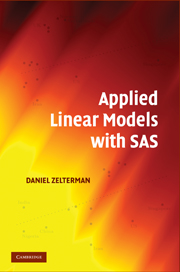Book contents
- Frontmatter
- Contents
- Preface
- Acknowledgments
- 1 Introduction
- 2 Principles of Statistics
- 3 Introduction to Linear Regression
- 4 Assessing the Regression
- 5 Multiple Linear Regression
- 6 Indicators, Interactions, and Transformations
- 7 Nonparametric Statistics
- 8 Logistic Regression
- 9 Diagnostics for Logistic Regression
- 10 Poisson Regression
- 11 Survival Analysis
- 12 Proportional Hazards Regression
- 13 Review of Methods
- Appendix: Statistical Tables
- References
- Selected Solutions and Hints
- Index
7 - Nonparametric Statistics
Published online by Cambridge University Press: 05 June 2012
- Frontmatter
- Contents
- Preface
- Acknowledgments
- 1 Introduction
- 2 Principles of Statistics
- 3 Introduction to Linear Regression
- 4 Assessing the Regression
- 5 Multiple Linear Regression
- 6 Indicators, Interactions, and Transformations
- 7 Nonparametric Statistics
- 8 Logistic Regression
- 9 Diagnostics for Logistic Regression
- 10 Poisson Regression
- 11 Survival Analysis
- 12 Proportional Hazards Regression
- 13 Review of Methods
- Appendix: Statistical Tables
- References
- Selected Solutions and Hints
- Index
Summary
Do you remember all of the assumptions that have to hold in order for statistical inference to be valid when we perform a t-test? What happens if the variances aren't equal in the two groups? Do you need to test for this? What happens if the data is not normally distributed? How can you tell when it is? What happens if there are outliers? How do you know for sure whether a given data point is an outlier? Statisticians tend to be a cautious bunch, but there is no need for you to be overly concerned. Nonparametric statistics are just the cure for messy data where outliers and highly skewed distributions would plague most analyses.
In a motivation for this chapter, suppose you learn that the average salary at a company has increased but at the same time the median income is unchanged. This means that most of the benefits were accrued by a few individuals, either at the top or at the bottom. In this example, is the average or the median more representative of the typical individual? We would like to cite a robust estimator that is not sensitive to a small number of unusually large or small values. In this example we see that the median remains unchanged if some of the largest or smallest values are altered.
Nonparametric methods are used for continuous, but not necessarily normally distributed data, with possible outliers.
- Type
- Chapter
- Information
- Applied Linear Models with SAS , pp. 150 - 168Publisher: Cambridge University PressPrint publication year: 2010



